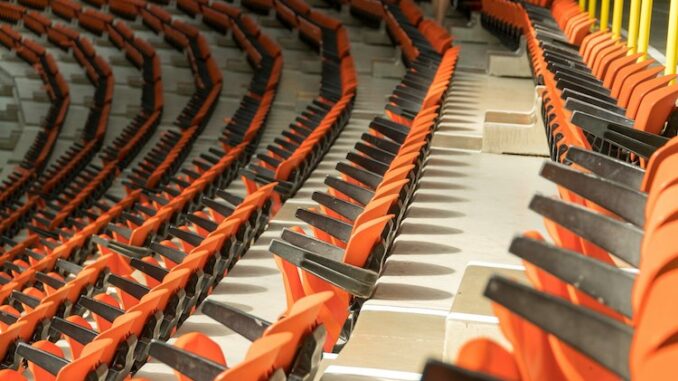
The latest survey of US spectator’s perceptions of venue safety and security highlights a preference for visible security measures and an ignorance of active shooter response policies.
According to the authors of the Spectator Sports Safety and Security Survey 2023 report, sport safety and security has become an increasing priority over the past decade for spectators and venue directors as threats to spectators have proliferated.
Recent studies from the US National Center for Sport Spectator Safety and Security (NCS4) have reported a marked increase in fan violence, alcohol- and drug-related incidents, terror threats, cybersecurity breaches, and other issues. At the same time, venue operators have looked to apply new technologies such as facial authentication, mobile ticketing, and touchless payment systems, to improve safety and guest experience.
Established in 2006, NCS4 at the University of Southern Mississippi (USM) is the United States’ only academic centre devoted to the study and practice of spectator sports safety and security.
The primary purpose of the Centre’s survey research is to gauge sport spectators’ perceptions of safety and security at live events, their awareness and support of policies and procedures, and their willingness to embrace new measures and technological solutions to enhance their safety and game-day experience.
The 47-question survey was developed with input from academics and practitioners, and with feedback solicited from NCS4 research affiliates, industry practitioners, and technology solution providers. An online data collection and analysis organisation distributed the survey in June 2023. 400 individuals 18 or older who attended a live professional or intercollegiate sporting event within the last year completed the survey.
Read this article in the digital edition:
Threats and technologies
Top-rated threat and safety concerns included theft, the use of weapons, unsafe parking, alcohol abuse, inadequate security personnel, inadequate security screening, and fan violence. Participants were least concerned with cyberattacks and natural disasters. Participants were least concerned with cyberattacks and natural disasters.
Approximately two-thirds of participants trust venues’ measures to protect them from active shooters, vehicle ramming incidents, and Personal Identifiable Information (PII) breaches.
69.3% consider safety and security measures when attending a sporting event, and 73% preferred visible security measures. Participants highly supported venue security staff presence, law enforcement presence, walk-through screening detection technologies, security wands, visible security cameras, and designated entry gates.
These were closely followed by fan code of conduct, secure in-house WiFi networks, perimeter barriers, bag searches, and body cameras. 77.1% feel comfortable with security personnel wearing body cameras, and 70.6% indicated venue cleanliness and high sanitation standards made them feel safe. No-bag policies, social media monitoring, and robots employed in security roles were less preferred.
Fan behaviour and spectator experience
Parking, traffic, locating seats and restrooms, and security screening were highlighted as points of difficulty by event attendees. 31.6% indicated that security procedures entering the event negatively affected their experience.
Half of the participants (50.2%) preferred an entry screening method that requires people to pass through individually rather than one that allows many people to pass through at once (31%), while 18.8% had no preference. 52.3% indicated they would welcome facial authentication/validation as part of the venue entry process.
Top-rated incidents witnessed or experienced by participants at a sporting event included alcohol abuse, fan violence inside and outside the venue, severe weather, and tailgating incidents. These were closely followed by unsafe parking, theft, crowd crush, and entry/exit panic. 28.7% of participants witnessed or experienced unequal/unfair enforcement actions by security staff.
66.8% had observed disruptive fan behaviour at a live event attended, with over half of them choosing not to report the incident. 23% stated they had been a victim of disruptive fan behaviour, with the majority reporting it to the proper authority. Despite this, 74% responded that they feel safe with the ability to report an incident inside the venue.
The majority of participants noted that fan behaviour had not changed from three years previously, and that fan behaviour affected their decision to attend future live events.
Approximately 70% of respondents stated that they would be willing to pay a nominal security ticket fee, ranging from $0.50 – $5.00, to offset event safety and security costs.

Policies and procedures
When asked the extent of their familiarity and agreement with venue safety and security policies and procedures, participants were most familiar with the prohibited items policy, fan code of conduct, alcohol policy, emergency medical procedures, drug policy, and ejection policy.
Interestingly, the lowest familiarity and agreement ratings were reserved for the active shooter response and severe weather policy. The 18-24 age category was the least familiar or second least familiar with every policy and procedure.
Most participants knew of their event’s safety and security measures before attending and how to seek emergency help at a sporting event. Preferred safety and security communication methods before an event included website (53.8%), venue/event apps (39.8%), signage at the entry point (38.3%), and signage in the venue (33.8%).
Participants in all age ranges heavily relied on communications via website. The 45-54 age range was the only group that relied more on other communication platforms, such as entry (45%) and venue (42%) signage, compared to website (39%).
In conclusion, the report authors suggested that venue and event security management may consider the following recommendations:
- Encourage early entry to the event, monitor tailgating areas, and ensure staff are adequately trained on ticketing and screening procedures.
- Be mindful of access and functional needs (entry accessibility, access control, wayfinding, emergency response, and evacuation procedures) and train staff in relation to these.
- Visible security measures increase spectators’ sense of safety, reinforcing the value of law enforcement and security staff, entry screening technologies, CCTV, and security personnel body cameras. Provide a mechanism for spectators to report incidents inside the venue.
- Facility hygiene remains important to spectators. Custodial staff should maintain cleanliness and high sanitation standards throughout the event.
- Conduct an event-specific risk assessment to guide planning and preparedness efforts.
- Develop plans, policies, and procedures, and train staff (full-time, part-time, third party, and contractors), and exercise plans.
- Be aware of the policies spectators are least familiar with. Communicate safety and security messaging to spectators before, during, and post-event via website, venue apps, signage, and announcements. Consider spectator demographics for targeted communications.
- Address disruptive fan behaviour with a fan code of conduct and substantial violation penalties, train staff on pre-incident behaviours, crowd management, and de-escalation techniques. Encourage spectators to report such behaviour.
- Review traffic control procedures and ensure adequate lighting of parking lots and pathways. Increase signage, train staff on guest relations, and ensure consistent screening procedures to overcome points of difficulty for spectators.
- Consider utilising facial authentication/validation for spectator entry. A trial period may be helpful to educate spectators on purpose and benefits.
- Consider a nominal ticket security surcharge to fund security budgets.









